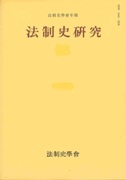Current issue
Displaying 1-50 of 71 articles from this issue
Articles
-
2018 Volume 67 Pages 1-51,en3
Published: March 30, 2018
Released on J-STAGE: November 30, 2023
Download PDF (1901K) -
2018 Volume 67 Pages 53-101,en5
Published: March 30, 2018
Released on J-STAGE: November 30, 2023
Download PDF (1870K) -
2018 Volume 67 Pages 103-159,en7
Published: March 30, 2018
Released on J-STAGE: November 30, 2023
Download PDF (2009K) -
2018 Volume 67 Pages 161-199,en9
Published: March 30, 2018
Released on J-STAGE: November 30, 2023
Download PDF (1863K)
Symposium
-
2018 Volume 67 Pages 201-209,en11
Published: March 30, 2018
Released on J-STAGE: November 30, 2023
Download PDF (1697K) -
2018 Volume 67 Pages 210-222
Published: March 30, 2018
Released on J-STAGE: November 30, 2023
Download PDF (1623K) -
2018 Volume 67 Pages 223-236
Published: March 30, 2018
Released on J-STAGE: November 30, 2023
Download PDF (4234K) -
2018 Volume 67 Pages 237-270
Published: March 30, 2018
Released on J-STAGE: November 30, 2023
Download PDF (3925K) -
2018 Volume 67 Pages 271-284
Published: March 30, 2018
Released on J-STAGE: November 30, 2023
Download PDF (1568K) -
2018 Volume 67 Pages 285-292
Published: March 30, 2018
Released on J-STAGE: November 30, 2023
Download PDF (1783K) -
2018 Volume 67 Pages 293-301
Published: March 30, 2018
Released on J-STAGE: November 30, 2023
Download PDF (2484K) -
2018 Volume 67 Pages 302-308
Published: March 30, 2018
Released on J-STAGE: November 30, 2023
Download PDF (1542K)
-
2018 Volume 67 Pages 309-314
Published: March 30, 2018
Released on J-STAGE: November 30, 2023
Download PDF (1615K) -
2018 Volume 67 Pages 314-319
Published: March 30, 2018
Released on J-STAGE: November 30, 2023
Download PDF (1538K) -
2018 Volume 67 Pages 319-324
Published: March 30, 2018
Released on J-STAGE: November 30, 2023
Download PDF (1539K) -
2018 Volume 67 Pages 324-330
Published: March 30, 2018
Released on J-STAGE: November 30, 2023
Download PDF (1541K) -
2018 Volume 67 Pages 330-335
Published: March 30, 2018
Released on J-STAGE: November 30, 2023
Download PDF (1551K) -
2018 Volume 67 Pages 336-342
Published: March 30, 2018
Released on J-STAGE: November 30, 2023
Download PDF (1787K) -
2018 Volume 67 Pages 342-347
Published: March 30, 2018
Released on J-STAGE: November 30, 2023
Download PDF (1615K) -
2018 Volume 67 Pages 347-352
Published: March 30, 2018
Released on J-STAGE: November 30, 2023
Download PDF (1615K) -
2018 Volume 67 Pages 352-357
Published: March 30, 2018
Released on J-STAGE: November 30, 2023
Download PDF (1550K) -
2018 Volume 67 Pages 357-360
Published: March 30, 2018
Released on J-STAGE: November 30, 2023
Download PDF (1545K) -
2018 Volume 67 Pages 361-363
Published: March 30, 2018
Released on J-STAGE: November 30, 2023
Download PDF (1541K) -
2018 Volume 67 Pages 363-365
Published: March 30, 2018
Released on J-STAGE: November 30, 2023
Download PDF (1541K) -
2018 Volume 67 Pages 365-367
Published: March 30, 2018
Released on J-STAGE: November 30, 2023
Download PDF (1605K) -
2018 Volume 67 Pages 367-369
Published: March 30, 2018
Released on J-STAGE: November 30, 2023
Download PDF (1592K) -
2018 Volume 67 Pages 369-372
Published: March 30, 2018
Released on J-STAGE: November 30, 2023
Download PDF (1608K) -
2018 Volume 67 Pages 372-375
Published: March 30, 2018
Released on J-STAGE: November 30, 2023
Download PDF (1608K) -
2018 Volume 67 Pages 375-377
Published: March 30, 2018
Released on J-STAGE: November 30, 2023
Download PDF (1604K) -
2018 Volume 67 Pages 378-380
Published: March 30, 2018
Released on J-STAGE: November 30, 2023
Download PDF (1542K) -
2018 Volume 67 Pages 381-382
Published: March 30, 2018
Released on J-STAGE: November 30, 2023
Download PDF (1538K) -
2018 Volume 67 Pages 383-387
Published: March 30, 2018
Released on J-STAGE: November 30, 2023
Download PDF (1924K) -
2018 Volume 67 Pages 387-389
Published: March 30, 2018
Released on J-STAGE: November 30, 2023
Download PDF (2289K) -
2018 Volume 67 Pages 389-391
Published: March 30, 2018
Released on J-STAGE: November 30, 2023
Download PDF (1604K) -
2018 Volume 67 Pages 391-393
Published: March 30, 2018
Released on J-STAGE: November 30, 2023
Download PDF (1604K) -
2018 Volume 67 Pages 393-395
Published: March 30, 2018
Released on J-STAGE: November 30, 2023
Download PDF (1550K) -
2018 Volume 67 Pages 395-398
Published: March 30, 2018
Released on J-STAGE: November 30, 2023
Download PDF (1553K) -
2018 Volume 67 Pages 398-401
Published: March 30, 2018
Released on J-STAGE: November 30, 2023
Download PDF (1544K) -
2018 Volume 67 Pages 401-404
Published: March 30, 2018
Released on J-STAGE: November 30, 2023
Download PDF (1553K) -
2018 Volume 67 Pages 404-407
Published: March 30, 2018
Released on J-STAGE: November 30, 2023
Download PDF (1548K) -
2018 Volume 67 Pages 408-414
Published: March 30, 2018
Released on J-STAGE: November 30, 2023
Download PDF (1560K) -
2018 Volume 67 Pages 414-419
Published: March 30, 2018
Released on J-STAGE: November 30, 2023
Download PDF (1550K) -
2018 Volume 67 Pages 419-424
Published: March 30, 2018
Released on J-STAGE: November 30, 2023
Download PDF (1552K) -
2018 Volume 67 Pages 424-429
Published: March 30, 2018
Released on J-STAGE: November 30, 2023
Download PDF (1553K) -
2018 Volume 67 Pages 429-434
Published: March 30, 2018
Released on J-STAGE: November 30, 2023
Download PDF (1551K) -
2018 Volume 67 Pages 434-439
Published: March 30, 2018
Released on J-STAGE: November 30, 2023
Download PDF (1552K) -
2018 Volume 67 Pages 439-445
Published: March 30, 2018
Released on J-STAGE: November 30, 2023
Download PDF (1909K) -
2018 Volume 67 Pages 445-450
Published: March 30, 2018
Released on J-STAGE: November 30, 2023
Download PDF (1555K) -
2018 Volume 67 Pages 450-455
Published: March 30, 2018
Released on J-STAGE: November 30, 2023
Download PDF (1552K) -
2018 Volume 67 Pages 455-461
Published: March 30, 2018
Released on J-STAGE: November 30, 2023
Download PDF (1553K)
